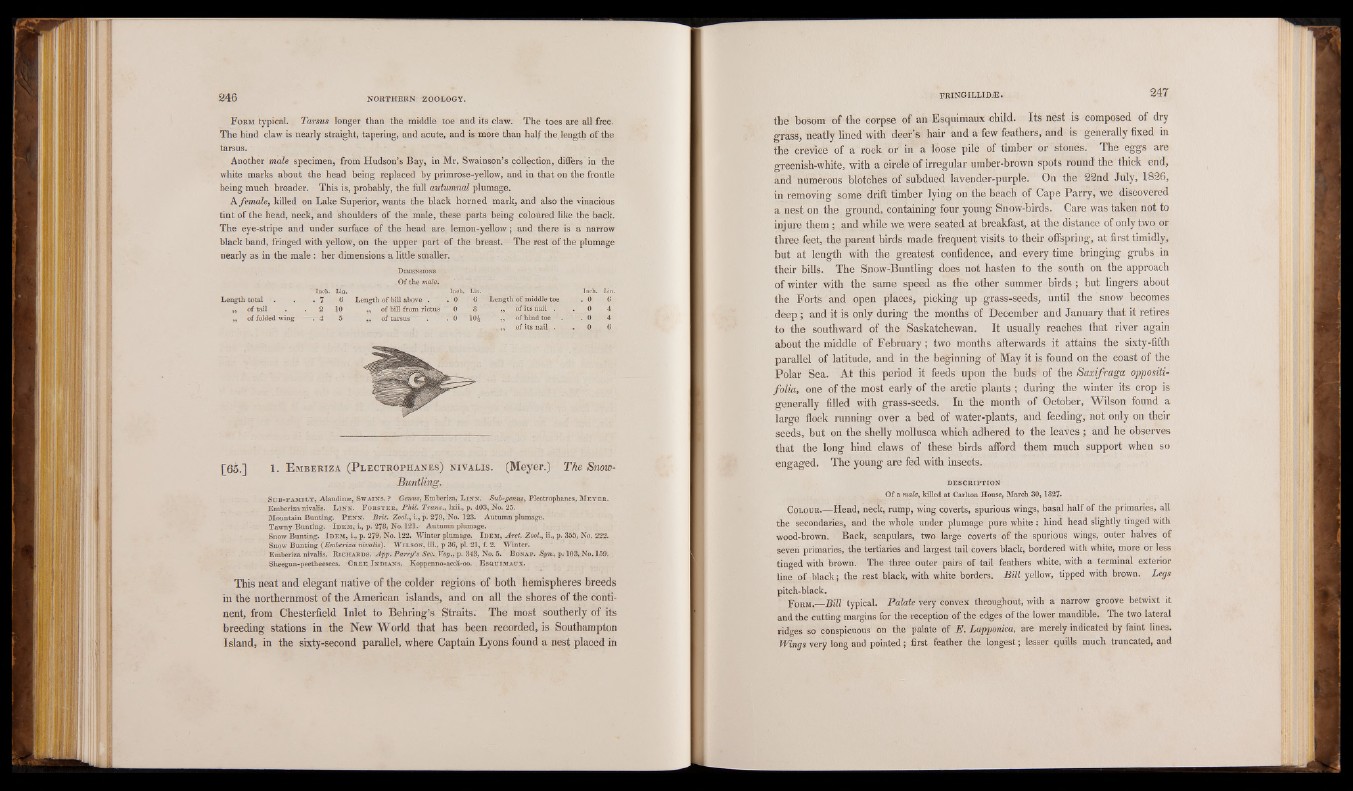
F orm typical. Tarsus longer than the middle toe and its claw. The toes are all free.
The hind claw is nearly straight, tapering, and acute, and is more that) half the. length of the
tarsus.
Another male specimen, from Hudson’s Bay, in Mr. Swainson’s collection, differs in the
white marks about the head being replaced by primrose-yellow, and in that on the frontle
being much broader. This is, probably, the full autumnal plumage.
A female, killed on Lake Superior, wants the black horned mark, and also the vinacious
tint of the head, neck, and shoulders of the male, these parts being coloured like the back.
The eye-stripe and under surfa.ce of the head are lemon-yellow; and there is a narrow
black band, fringed with yellow, on the upper part of the breast. The rest of the plumage
nearly as in the male : her dimensions a little smaller.
Dimensions
, Of the male.
"eIiich. Lin. Inöh. Lin. Inch. Lin
Length total . 7 6 Length of bill above . . 0 6 Length of middle toe . 0 6
„ of tail 2 19 ,, of bill from rictus 0 8 of Its hail . • o 4
„ of folded wing —r-4 5 „ of tarsus . . 0 10§ „ of hind toe . ' . 0 4
. of its nail . . 1 6
[65.] 1. E mberiza (P lectrophanes) nivalis. (Meyer.) The Srww-
Buntling.
Su b -f a m il y , Alaudinse, Sw a in s. ? Genus, Emberiza, L in n . Sub-germs, Plectrophanes, M e y e r .
Emberiza nivalis. L in n . Forster, PMl. Trans., Ixdi., p. 403, No. 25.
Mountain Bunting. P e n n . Brit. Zool., i., p. 279, No. 123. Autumn plumage.
Tawny Bunting. I d em , i., p. 278, No. 121. Autumn plumage.
Snow Bunting. I d em , i., p. 279, No. 122. Winter plumage. I d em , Arct.Zool., ii., p. 355,No. 222.
Snow Bunting (Emberiza nivalis). ’ W ilso n , iii., p 36, pi. 21, f. 2. Winter.
Emberiza nivalis. R i c h a r d s . App. Parry’s Sec,. Voy., p . 34 3, No. 5 . B o n a p . Syn;, p . 10 3, No. 159.
Sheegun-peetheesees. C r e e I n d ia n s. Koppenno-accS-oo. E sq u im a u x .
This neat and elegant native of the colder regions of both hemispheres breeds
in the northernmost of the American islands, and on all the shores of the Continent,
from Chesterfield Inlet to Behring’s Straits. The most southerly of its
breeding stations in the New World that has been recorded, is Southampton
Island, in the sixty-second parallel, where Captain Lyons found a nest placed in
the bosom of the corpse of an Esquimaux child. Its nest is composed of dry
grass, neatly lined with deer’s hair and a few feathers, and is generally fixed in
the crevice of a rock or in a loose pile of timber or stones. The eggs are
greenish-white, with a circle of irregular umber-brown spots round the thick end,
and numerous blotches of subdued lavender-purple. On the 22nd July, 1826,
in removing some drift timber lying on the beach of Cape Parry, we discovered
a nest on the ground, containing four young Snow-birds. Care was taken not to
injure them; and while we were seated at breakfast, at the distance of only two or
three feet, the parent birds made frequent visits to their offspring, at first timidly,
but at length with the greatest confidence, and every time bringing grubs in
their bills. The Snow-Buntling does not hasten to the south on the approach
of winter with the same speed as the other summer birds; but lingers about
the Forts and open places, picking up grass-seeds, until the snow becomes
deep; and it is only during the months of December and January that it retires
to the southward of the Saskatchewan. It usually reaches that river again
about the middle of February ; two months afterwards it attains the sixty-fifth
parallel of latitude, and in the beginning of May it is found on the coast of the
Polar Sea. At this period it feeds upon the buds of the Saxifraga oppositi-
folia, one of the most early of the arctic plants ; during the winter its crop is
generally filled with grass-seeds. In the month of October, Wilson found a
large flock running over a bed of water-plants, and feeding, not only on their
seeds, but on the shelly mollusca which adhered to the leaves ; and he observes
that the long hind claws of these birds afford them much support when so
engaged. The young are fed with insects.
DESCRIPTION
Of a male, killed at Carlton House, March 30, 1827*
C olour.—Head, neck, rump, wing coverts, spurious wings, basal half of the primaries, all
the secondaries, and the whole under plumage pure white : hind head slightly tinged with
wood-brown. Back, scapulars, two large coverts of the spurious wings, outer halves of
seven primaries, the tertiaries and largest tail covers black, bordered with white, more or less
tinged with brown. The three outer pairs of tail feathers white, with a terminal exterior
line of black; the rest black, with white borders. Bill yellow, tipped with brown. Legs
pitch-black.
Form.—Bill typical. Palate very convex throughout, with a narrow groove betwixt it
and the cutting margins for the reception of the edges of the lower mandible. The two lateral
ridges so conspicuous on the palate of E. Lapponica, are merely indicated by faint lines.
Wings very long and pointed; first feather the longest; lesser quills much truncated, and